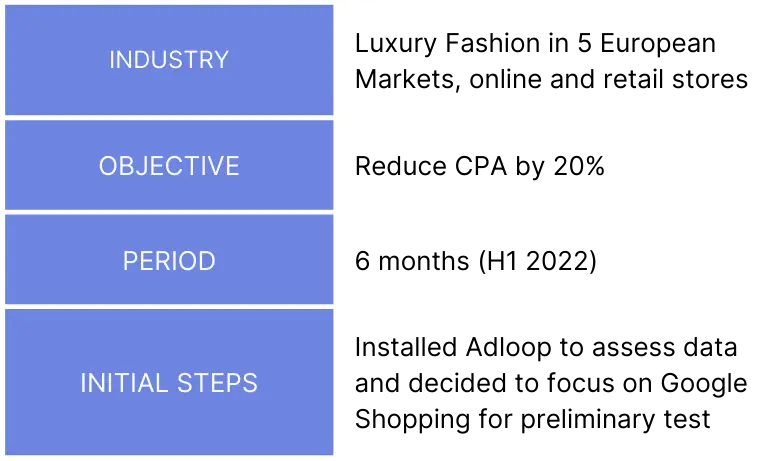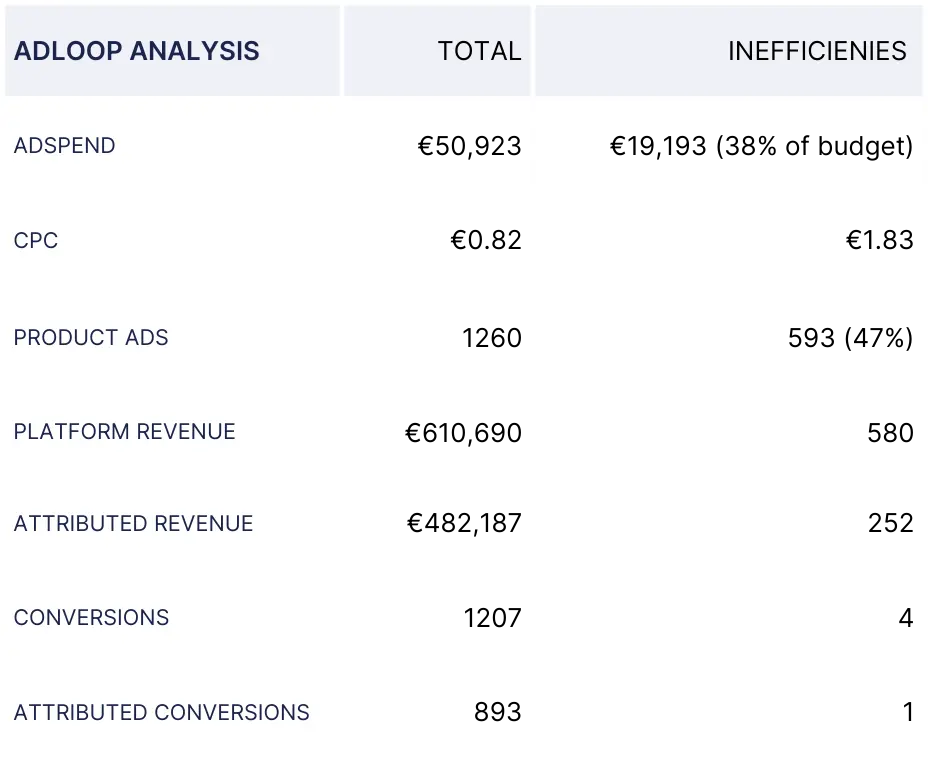The Executive Guide to
Marketing Optimization
Essential steps to improving sales, save time & money
Diving deeper into the world of digital ad optimization with Adloop. Learn more about how to empower your marketing team and budget to grow your business.
Discover more in the deep dive sections below.
MAD
Machine learning, Artificial Intelligence, Data
We live in a world where technology is omnipresent and increasingly powerful; autonomous vehicles, real-time translation, generative AI, the list goes on
Our cognitive world is saturated with information about the superiority of AI over human intelligence. However, and without denying the immense contribution of digital technology in our lives, a part of this conviction is also a matter of marketing strategy from technology vendors.
Advertising platforms are not the last to promote an aggressive technological marketing.
‘Google Machine Learning Grows Your Business Faster’
https://www.blog.google/products/ads/adwords-machine-learning-part-1/
‘Powering Up Performance Through Meta Advantage’ Automation Ad Suite’
https://www.facebook.com/business/news/meta-advantage-automation-ad-suite-performance
The message is clear:
Machine learning, algorithms, and automation are faster and can do better than humans.
“Let us take care of your budget and relax”
This automation narrative is supported by media agencies also. They benefit from automated campaign management to save precious human resources, and by doing so, maintain their premium partner status with ad platforms.
However, Google and Meta auto-bidding algorithms are not magical. They are designed based on rules. The ad platform rules (and objectives) are not aligned to the advertiser’s own objectives in terms of ad revenue generation and inventory management.
By removing real people from the management of ad campaigns, ad platforms make more room to protect their own economic interests.
Maintaining the illusion of the superiority of algorithms over people is also a marketing strategy.
Keeping the hand on the daily management of ad campaigns, such as the evaluation of campaign results provides power to challenge ad strategies which is critical for any advertiser who wants to grow sales through marketing optimization.
Want to reduce your Google CPA in weeks?
Speak to a specialist. We will help you reduce your CPA through better reporting & ad optimization recommendations.The Confirmation Bias
People have a natural tendency to seek out information that confirms their existing beliefs and reject information that challenges them, a phenomenon known as Confirmation Bias.
This cognitive shortcut, well known to psychologists, allows individuals to simplify the processing of information and make quicker decisions. However, it can also lead to a bias in thinking and decision-making.
Digital marketers are under pressure to produce results and manage large amounts of data. They can fall into this bias trap by focusing on positive information that confirms the effectiveness of their actions, rather than actively seeking out evidence to the contrary.
This is further exacerbated by the nature of the digital marketing value chain, where platforms and agencies may put forward ‘positive’ data, in order to justify the budget usage.
Yet this may seem counterintuitive or even contradictory, but the best way to prove hypotheses is to look for evidence to the contrary. Scientific experiments worth considering are refutable; there are cases where they are not applicable. A theory that cannot be disproved is not considered valid by the scientific community.
Applied to digital marketing operations, confirmation bias is often emphasizing one KPI which is confirming your intuition and ignoring another which could provide better insights
Example. A social ad campaign with a lot of impressions but with low click rate.
Confirmation bias might lead a marketer to focus on the positive (number of impressions) and relegate the negative (low click rate)
“It’s a brand awareness campaign, we want visibility“. Seeking evidence of the contrary could be “Impressions are good but the low click rate could mean people are not engaged by the creative and/or interested in the product.”
The campaign might not be so good even though it’s about brand building.
Today, ad platforms and many agencies tend to focus on systematic confirmation, isn’t it the advertiser’s role to be in a better position to challenge systematic reporting & information?
the impact of Awareness KPIs
Among the most popular metrics in brand awareness campaigns are impressions and CPM. If you think about it, these ad metrics don’t provide real value about the impact of campaigns on people.
An impression is purely a technical measurement counting the number of ads served. There is no information on whether the ads were seen by real people. Most of the time, ads are ‘pre-loaded’ wherever they are located on a single page, and most of them are usually located below the fold of the browser. If the user does not scroll, the impressions will be counted but never seen.
In addition, some ad blockers remove the ad in the browser but still counted as an impression because it was served by the ad server. Lastly, ad fraud is plagues programmatic display, search and social networks, “impression stacking” or “ad cloaking” techniques make the ad impressions counters run without ever showing any ad.
CPM (Cost per thousand impressions) The standard business model of display advertising is per impression basis. However, CPM does not say anything about the relevance of the audience, nor if the users will see the ad as aforementioned. Display ad inventories are available for a few cents per 1,000 impressions. On the other hand, premium inventories are offered at tens of euros. In both use cases, advertisers are severely challenged to assess CPM impact of displayed ads with an audience.
A broad estimate (various sources including Google) is that 50% to 80% of ad impressions are never seen by the targeted audience. With such a loss, impressions and CPM do not make much sense.
Advertisers should focus on impact-oriented KPIs that demonstrate a real person actually viewed or engaged with the intended ad. Some examples of impact-oriented KPIs include:
- Social reactions (Follow, like, share, swipe)
- Completion rates for videos
- Clicks and Click-through rate
- Visible impressions
Usecase: Google Shopping CPA
Background
A luxury retailer in the fashion industry wants to lower Google Shopping CPA. They’re objective is to lower thier CPA by 20%. A small marketing team of 3 along with 2 agencies manage 5 EU markets for the brand. To demonstrate the power of marketing optmization, the fashion brand work with Adloop optimization specialists, using Adloop tools to embark on the primary CPA objective.

Starting Point
The baseline starting point in February 2022 had Google Shopping CPA at €42.5. The target CPA was to get to €30.0.

According to Google, the Shopping campaign has a good optimization rate (note: Search Ads 360 is in use for Google Search & Shopping campaigns with a ROAS strategy).
First Analysis
Non-performing product ads were identified and isolated. The criteria included ‘0’ or very low attributed revenue’, ‘high attributed CPA’, ‘high cost per engaged visit’. The preliminary assessment found 38% of the campaign adspend (€19,2K) was delivering no conversions & high-cost visits. 47% of the product ads were costing 2.3X the average CPC without bringing any benefit to the fashion brand.

Recommendations
It was decided to keep the ineffective product ads active and reduce the CPC budget. Here’s the ad optmization:
- Isolate the 593 product ads in an independent campaign
- The campaign was switched to manual (without Search Ads 360) with a maximum CPC of €1 and a maximum budget of €300 per day.
- The remaining campaigns were kept active and operated by Search Ads 360 with a small reduction in the maximum daily budget.
- It was agreed to run this test for 30 days with weekly data analysis & verification.
Results
After 30 days of optimization (Mar to Feb 2022) the the fashion brand achieved the following results:
- Decrease of the Google Shopping budget: €7,500 (-15%)
- Increase in Google Shopping conversions: +105 conversion (+8.7%)
- Decrease of the Google Shopping CPA: €30.5/ sale (vs. the initial €42.5, decrease of -28%)
BEFORE

AFTER

Conclusion
The Fashion brand achieved its objective faster than ever imaged. With an optimization plan and independent tools to assess Google Shopping ad reporting the brand was able to achieve very positive results on all KPIs in a matter of weeks.
defining thresholds for important KPIs?
Advertiser : One of my marketing goals from paid campaigns is to engage customers on my site. I want customers who are inclined to purchase my products or share with friends.
Optimization guy : Perfect, first lets define what is an engaged visitor. What do you want the customer to do on your site?
Advertiser : Well, I want them to view my products, check the design, the fabric, price options. It’s a first step before deciding to purchase.
Optimization guy : OK, in term of data, what about defining an engaged visit as : a visit with 2 page views or more and at least 1 product page view. Is that relevant ?
Advertiser : Yes, seems to be good. What’s next ?
…Optimization guy is setting up the Engaged visit KPI – called Useful click in Adloop…
Optimization guy : OK now we have to define thresholds. We need to find an answer to this question How much do you want to pay for engaged visits on your site? I know this is not that simple. So let’s go step by step. Let’s dig into your data.
…Optimization guy & Advertiser are checking the cost & click data from Google & Meta and also the bounce rate in Google Analytics…
Optimization guy : After analyzing the data, I see that your average CPC is about €1 / click and the bounce rate is 50%. Assuming all clicks make it to your site, today you are paying €2 / unbounced click. Engaged visits are fewer so you might pay them around €3/ click. Are you happy with this?
Advertiser : I would like it to be better
Optimization guy : OK then based on your engagement objective. we can define the following
- Engaged visits is a relevant KPI to measure the quality of traffic from your paid campaigns
- Ads bringing traffic for less that €1,5 / engaged visit are Good
- If the cost per engaged visit is more that €4 then the ads are performing badly
Does this make sense?
Advertiser : It seems perfect. And now that we have defined this threshold, how should we use it?
Optimization guy : For campaigns whose goal is engaged/consideration, we can use this KPI and the defined thresholds regardless of channel.
Ads sending engaged visits for more than €4 should be checked; you might stop them or change some delivery options such as spending limits in order to try to lower the CPC.
Ads with cost per engaged visits is under €1.5 should be promoted to increase reach as they are bringing you engaged visits for a good value.
Advertiser : I understand, what about Awareness or Conversion goals.
Optimization guy : For those, the Cost per engaged visit can be considered as a secondary KPI to the main Awareness or Conversion lead KPIs you are using.
Let’s take a Conversion campaign, you might see ads with under-average Conversion KPIs (eg. attributed ROAS or attributed CPA. In this case, the secondary KPI can help you take the right decision on what you should do with those ads, leave them running without modifications or try to optimize them or even stop them.
Advertiser : Very clear, thank you Optimization guy.
